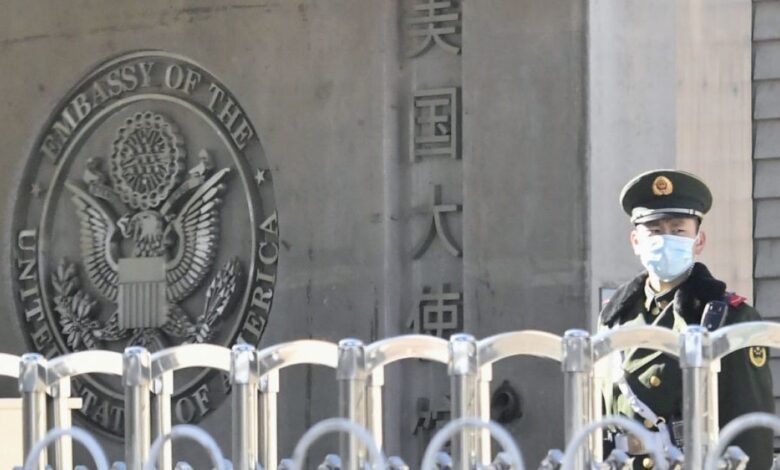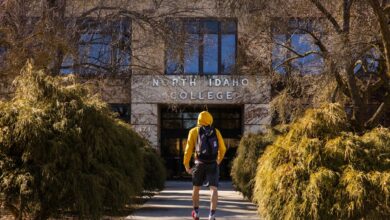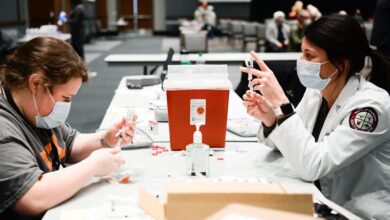New Student-Visa Data Paint an Optimistic Picture for Fall Enrollments

[ad_1]
As U.S. consulates around the world reopen, student-visa issuance is returning to pre-pandemic levels, bringing relief to American colleges that had feared yet another semester with many international students stranded overseas.
American consulates approved almost 117,000 F-1 student visas in May and June, or 93 percent of the number of student visas issued in the same two months in 2019, according to a Chronicle analysis of U.S. Department of State data. More than 143,000 F-1 visas were authorized from January to June of this year, 83 percent of the number issued during the same period two years ago.
The months leading up to the start of the fall semester — May, June, and July — are typically the busiest of the year for student-visa applications. On average, 60 percent of all F-1 visas are granted in those three months alone.
This year’s numbers reflect the clearing of a backlog, as not only new international students but also those who deferred or who studied remotely over the past year seek visas.
July data will not be available until August and could paint a different picture. And the emergence of the more contagious Delta variant of Covid-19 has tempered optimism about any return to normal travel and campus operations. But so far, the pace of visa issuance during the first two critical months should give colleges reason to be hopeful about a rebound in international enrollments.
In the 2020-21 academic year, the number of new enrollments of international students fell by 43 percent, the steepest decline of any demographic group.
At Grinnell College, in Iowa, Karen Klopp Edwards, dean of international-student affairs, “raised the red flag” throughout the spring, warning top administrators at the liberal-arts college, where about 20 percent of the student body is from overseas, that international students might again not be able to make it to the United States.
“I was so happy to be wrong because we’ll have all our students join us,” Edwards said. Grinnell expects 92 international first-year students this fall, on par with an average year, as well as 45 sophomores who will be coming to campus from abroad for the first time.
A major turning point for international students was the decision by the Biden administration in late April to give student-visa holders from Brazil, China, Iran, and South Africa a national-interest exemption, permitting them to come to the United States despite Covid 19-related travel restrictions. A few weeks later, U.S. consulates in China, which had been closed since the start of the pandemic, began processing student visas.
Student-visa issuances in China, the top source of international students on American campuses, are actually slightly ahead of the 2019 pace, with nearly 57,000 visas granted in May and June, compared with about 55,000 two years ago.
Globally, about 20 percent of U.S. consulates are now offering visa interviews within two weeks and 30 percent have availability in the next month. (New visa applicants are required to have in-person interviews with consular officers, although the mandate is sometimes waived for renewals.)
About a third of the consulates worldwide are offering appointments only on an emergency basis.
With consular services restarting and the national-interest exemption in place, F-1 visa issuance has begun to pick up speed around the globe. In the first four months of the year, by contrast, just 26,000 student visas were granted, about half of the number authorized in the same months in 2019.
At the University of Washington at Seattle, Kim Lovaas, director of international-student services, said there initially was a lot of anxiety about whether students would be able to get visas. “Then we were hit with a flood of requests,” she said, and have been “churning out” the documents students need for their visa applications.
Lisa J. Montoya, vice provost for global initiatives at the University of Texas at San Antonio, said fall enrollments are on track to match 2019 numbers — or do even better. “There’s pent-up demand, as you might imagine,” she said.
Bumps in the Road
There have been some hiccups and setbacks, however. Some graduate students in China have reported visa denials. The rejections are thought to be related to a presidential order, issued by the Trump administration, that blocks visas to students in certain scientific and technological fields who did their undergraduate work at universities that are alleged to have ties to the Chinese military.
In India, consulates were forced to stop nearly all visa services for several weeks in May and June, amid a new wave of Covid-19 cases there. Some 9,100 Indian students received visas during that time, just 60 percent of the volume of May and June 2019. The country is second only to China in the number of students it sends to the United States.
Visa appointments resumed in July, with consular officials pledging to prioritize student visas in an “intensive” two-month push. Sushil Sukhwani, who advises Indian students seeking to study abroad, said the “great majority” of his students had now gotten appointments for visa interviews in time for their program start dates, although some had to travel to other cities in India.
Edwards, the Grinnell dean, said she and her international-office staff had paid close attention to the problems at individual consulates, helping students troubleshoot and deal with roadblocks.
Not all of those setbacks have been strictly Covid-related. In Russia, the U.S. government has halted most visa services because of a geopolitical spat. So Alisa Sannikova, who will be a freshman at Grinnell, had to travel from Moscow to Warsaw to get an interview appointment. Fortunately, the process went smoothly, and Sannikova said she is “super-excited” to be coming the United States this fall.
Still, the uptick in visa issuance doesn’t mean the end of complications for international students. Many will still need to navigate quarantine and a lack of vaccine availability in their home countries. Sukhwani said many of his students had been vaccinated against the coronavirus but worry that their colleges won’t accept the inoculations because they haven’t been approved by the U.S. government. And international airfares are expensive, with flights from countries like China and India in short supply.
Sufei Li manages international programs at the American Association of State Colleges and Universities, which sponsors a dual-degree program in which Chinese students spend two years studying at an American college. The 200 students in the program this fall have succeeded in getting visas, but Li worries about finding affordable airfares. Some one-way ticket prices have risen as high as $10,000.
Lizhi Hu is looking forward to returning to the University of North Texas, where he is studying finance through the dual-degree program. He said he is “mostly excited and a little bit anxious” to come to the United States after more than a year of studying online.
“It would be great to meet professors and friends again,” Hu said. “Plus, I am really looking forward to starting a new stage of my life in America.”
[ad_2]
Source link






